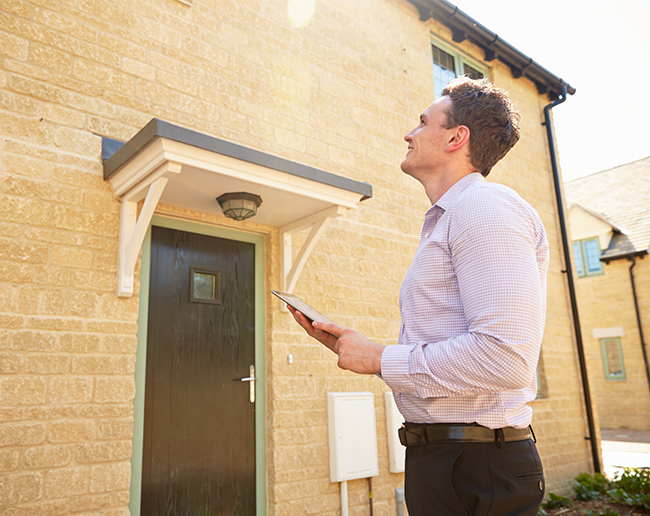Robin Johnson, managing director, professional services, at chartered surveying firm Kinleigh Folkard & Hayward, explains why you should know the difference between a valuation and the various types of surveys available when you purchase a house or flat
Buying a home is an emotional business for anyone, which may help explain why otherwise common-sense thinking can fly out of the window. Most of the purchases we make are made in response to fulfil an emotional need as well as a practical one. What we buy, and indeed whom we buy from, says something about us.
However, our haste can be our undoing. For evidence, you need look no further than most buyers’ decision to ignore getting a survey for the property of their dreams. As the most important purchase most of us make, too many of us readily ignore getting the full picture on the property we desire – leaving us open to substantial costs and embarrassment after the purchase.
So why do so many buyers continue to ignore surveys and use the mortgage valuation reports, written for their lender, to inform their buying decision?
If you ask most buyers whether they have had a survey done, many will assume the lender’s mortgage valuation (for which they paid) was their survey. While homebuyers mistakenly believe the mortgage lender’s valuation acts as their survey, the truth is that the basic valuation simply tells the lender that they are not lending more than the property is worth; and that, if sold by you, it will make back the amount borrowed.
Mortgage valuations, whether paid for or not by the borrower, are done for the lender’s benefit and are effectively a condition of a borrower receiving a mortgage offer.
So if you want to be protected get your survey carried out when you have an offer accepted on a property to find out about the condition of the building and whether you are paying the correct price for it.
The right kind of survey can help you find out about the condition of the building and, if there are problems, give you a powerful reason for negotiating the buying price down or asking the seller to fix the problems before you move in.
Three surveys
There are three main types of survey: the Condition Report, the Home Buyer Report and the Building Survey (also known as the full structural survey). The level of survey you need depends a lot on the individual property you are buying.
Condition Report
The Condition Report is the most basic survey you can get and will give you an overview of the property’s condition and highlight significant issues, but won’t go into detail. It will provide traffic light ratings for the condition of different parts of the property. It’s an entry level inspection that is appropriate for modern houses in good condition.
Crucially, the most significant difference in this report from any of the others is that the Condition Report does not include a valuation of the property or advice on future repairs and maintenance.
Home Buyer Report
The Royal Institution of Chartered Surveyors introduced the current Home Buyer Report in July 2009. It is designed to be user-friendly and for the most part avoids technical jargon and employs the traffic light Condition Ratings scheme.
Green means no repair is currently needed on the property and it should be maintained in the normal way.
Amber highlights defects that need repairing or replacing but are not considered to be either serious or urgent.
Red pinpoints serious defects that need to be repaired, replaced or investigated urgently.
The report is divided into easily readable and logical sections and, importantly, includes a number of appendices which tell buyers, or any legal advisers, what they ought to do next.
Probably the most important section is the surveyor’s overall opinion of the property and whether or not the surveyor considers the agreed purchase price to be reasonable. Of equal note is the section related to energy efficiency and the Energy Performance Certificate that must be prepared before a property is marketed.
Elsewhere there is an overview of the condition of the services based on a visual inspection.
The surveyor will not test the services as, for example, if the property is vacant the services may have been turned off or disconnected but the surveyor will recommend further investigations if these are considered appropriate.
Lastly, the surveyor will look for any potential problems such as flooding or the presence of asbestos-based materials.
Building Survey
The Building Survey is the most comprehensive available. It is suitable for any building, especially older buildings or those constructed out of unconventional materials and is not property type or age specific. For most houses or flats built of traditional stone or brick construction and in apparent good condition a Homebuyer Report is more than enough.
A Building Survey will examine the soundness of the structure, its general condition and all major or minor faults. More specialist surveys can also be carried out on aspects such as foundations, damp proofing, or tree roots, either by a specialist within the firm of surveyors or by an independent specialist surveyor. The report is extremely thorough as surveyors are legally obliged to inform you of all the findings of the survey.
A full Building Survey normally takes much longer than the one or two hours required for the Homebuyer Report. The survey report can also take a long time to produce. A Building Survey costs anything up to £1,000, depending on the price of the house.
The benefits of private surveys are fairly clear. Surveys have proved to save buyers money – and this trend will continue. Our ageing housing stock, which makes up by far the majority of homes in the UK, will over time encourage more buyers to seek out independent advice rather than rely on the mortgage lender’s valuation report.

AVMs
Possibly the most important point is not to confuse a lender’s mortgage valuation with a survey. Lenders are concerned with knowing the value and re-saleability of your property should you cease to be able to pay for it. They do not have to live in it.
To this end their concerns are materially very different to the extent that in many circumstances (remortgaging and some straightforward purchases) they will use Automated Valuation Models (AVMs) to determine the value of the property.
Partly in a bid to tackle the problem with delays, but also to cut their own costs, some lenders launched pilot schemes last year using AVMs, or desktop valuations, for certain types of purchases.
AVMs lend speed to the process and enable quicker processing of purchase applications. The approach has been used for remortgages for many years but is new in the process of house purchase. This approach extends the promise of improved customer experience, ensuring consistency and cutting property valuation times and frees up valuers’ capacity so they can focus on more complex cases.
After all that, if there is a mismatch between the automated valuation and the purchase price, lenders can call upon valuers to carry out a physical inspection of the property.
Non-standard construction
The variances of the many UK property types, geographies, and local buying markets mean that surveys will always remain a significant part of the process.
The increasing use of technology and databases to understand property value does, hopefully, mean we may have seen the end of long delays getting mortgage valuations and freeing up surveyors to carry out more Home Buyer surveys for the public at large.
Surveys matter because, in the heat of battle, they help us understand value – all the more important when you remember there are properties that banks and mortgage provides will not lend on.
Indeed, many lenders have policies that will exclude residential borrowing on properties of “non-standard construction”, which can refer to anything that is not brick, mortar and tile roofed. If you are purchasing a property that isn’t standard brick and tile construction, you may find that your chosen lender is not happy to offer you a mortgage.
Lenders always want to be sure that if for any reason they are forced to repossess the property, they are able to sell it to repay the outstanding mortgage debt quickly.
This can be more difficult with non-standard construction or non-traditional properties. Some of these difficult property types include high rise flats (even if ex-local authority), balcony access flats (including ex-local authority), timber framed houses, flying freeholds, properties with two kitchens, freehold flats, flats above food shops or next to some other commercial premises, or concrete construction.
To this end, understanding the nature of whatever you are buying, the advantages and some of the hidden pitfalls is crucial. While a survey can at first glance seem like another cost on top of the actual business of buying a home, it can save you thousands of pounds.
Our housing stock across the UK is ageing and, when it comes to property, with age comes sadly not wisdom but wear and tear, change and the scars of previous owners.




